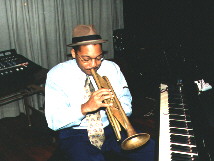
The trumpet is a brass musical wind instrument sounded by lip vibration against a cup mouthpiece. The modern trumpet has three valves, ordinarily built in B flat, and maintains the traditional trumpet bore, cylindrical with a terminal bell flare, though usually the bore tapers towards the mouthpiece to provide additional flexibility in tone. The bend near the bell incorporates a tuning slide. It has a range of about three octaves extending upward from F sharp below middle C, depending on the player's skill. The music notated is a major second higher than the actual sound.

Instruments in keys other than B flat are frequently used. The "piccolo" trumpet in D, also known as the Bach trumpet, was invented in about 1890 by the Belgian instrument maker Victor Mahillon for use in the high trumpet parts of music by J.S. Bach and Georg Friedrich Händel. (It is the familiar sound used in the instrumental break in the middle of the Beatles song "Penny Lane.") Other forms include the older E flat trumpet, the trumpet in C, piccolo trumpets in F and high B flat, and the bass trumpet in B flat.
The metal trumpets date from 2000 BC in Egypt where it was barely two feet long and used only as a ritual or military instrument. Other variations included the Greek salpinx (made from 13 fitted sections of ivory with a bronze bell), the Roman tuba Roman lituus (a J-shaped instrument), and the buisine (a long trumpet, about six feet long associated with royalty and pomp). By 1400, the tube of the trumpet had been lengthened to the extent that the trumpet was bent into an S-shape for manageability, and in 1500 it acquired its present shape.
Musicians of the 1700s were reluctant to let trumpeters join their string-based ensembles because their playing was liable to drown them out. Because of this, instrument makers set about improving the trumpet. They pitched it in different keys, using a crook to change the tonality of the trumpet. It was given a shallower mouthpiece, which made it easier for the player to reach higher notes. This led to a much softer style of playing known as clarino, which was pitched quite high and contained some delicate tone colours that were achieved by changing the shape of the mouth.


The valve trumpet appeared in Germany at about 1828. Its acceptance was delayed in the US and Great Britain because players preferred the cornet in the orchestral trumpet parts. This trumpet had three valves from which it was possible to play seven different harmonic series. However, classical solo repertoire for the trumpet was still very small.
The popularisation of jazz after the Second World War saw the trumpet make its way into the jazz ensemble as an ideal lead instrument with the tone qualities that was brash, raunchy and loud enough to cut across the night club atmosphere.
Famous classical trumpeters include French Maurice Andre and Adolph Herseth, who plays in the Chicago Symphony Orchestra. Good jazz trumpeters include Miles Davis and Clifford Brown. But of course, the most famous and influential of them all is Wynton Marsalis (pictured above), who has made his name in both jazz and classical music.